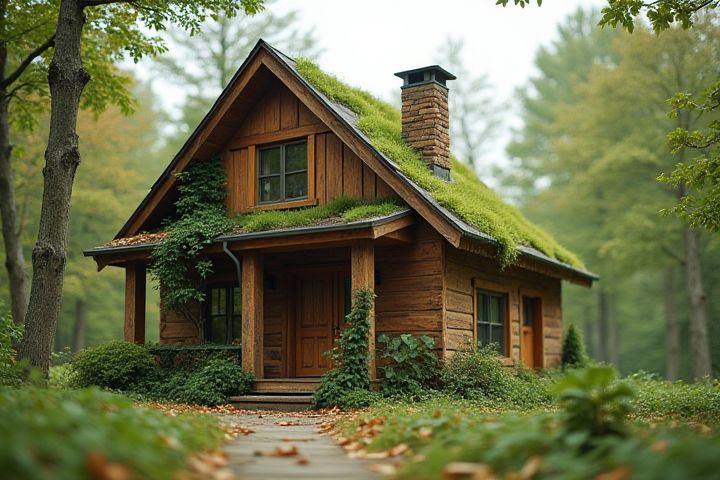
An eco-conscious house is designed with sustainable materials, energy-efficient systems, and innovative technologies to minimize its environmental impact. Utilizing solar panels can significantly reduce electricity costs while harnessing renewable energy. Proper insulation and energy-efficient windows help maintain a comfortable interior climate, reducing reliance on heating and cooling systems. Rainwater harvesting systems can provide a sustainable water source for irrigation, while native landscaping minimizes water usage and supports local biodiversity. By integrating smart home technologies, you can monitor and manage energy consumption, making it easier to live sustainably.
Can A House Be Eco-Conscious
Sustainable materials
A house can be eco-conscious by incorporating sustainable materials such as bamboo flooring, recycled metal roofing, and reclaimed wood for framing and cabinetry. These materials not only reduce environmental impact but also enhance energy efficiency, promoting a healthier indoor atmosphere. Insulation made from recycled denim or cellulose derived from recycled paper further optimizes thermal performance while minimizing waste. By choosing eco-friendly paints and finishes that are low in volatile organic compounds (VOCs), you can create a safe living space while supporting sustainable manufacturing practices.
Energy-efficient appliances
An eco-conscious house prioritizes energy-efficient appliances, which significantly reduce energy consumption and lower utility bills. These appliances, such as ENERGY STAR-rated refrigerators and washing machines, utilize advanced technology to minimize waste while maintaining optimal performance. By choosing energy-efficient options, you contribute to a decrease in greenhouse gas emissions, promoting a healthier environment. Incorporating these appliances into your home not only benefits your wallet but also aligns with sustainable living practices.
Solar power integration
A house designed with an eco-conscious focus can harness solar power through the integration of photovoltaic (PV) panels, which convert sunlight into electricity. By installing solar energy systems, you can significantly reduce your carbon footprint and lower energy bills, while benefiting from various incentives such as tax credits and rebates. Energy-efficient appliances and smart home technology further optimize energy consumption, making the home not only sustainable but also cost-effective. With advancements in solar battery storage, excess energy generated during the day can be stored for use at night, ensuring a reliable and clean energy supply.
Rainwater harvesting
A house can be designed with an eco-conscious focus by incorporating rainwater harvesting systems that capture and store rainwater for various uses, such as irrigation, flushing toilets, and even potable water after proper filtration. Implementing a rainwater harvesting system not only reduces dependence on municipal water supplies but also minimizes stormwater runoff, which can lead to soil erosion and water pollution. To enhance sustainability, consider integrating permeable paving, green roofs, and native landscaping that complements your water management strategy. Investing in such features not only benefits the environment but also leads to significant cost savings on your water bills over time.
Proper insulation
Proper insulation is crucial for an eco-conscious house, as it significantly reduces energy consumption and greenhouse gas emissions. By selecting high-quality materials, such as cellulose, spray foam, or fiberglass, you can enhance thermal efficiency and maintain a comfortable indoor climate year-round. Efficient insulation minimizes the need for heating and cooling systems, resulting in lower utility bills and a reduced carbon footprint. Investing in proper insulation not only suits your sustainability goals but also increases the long-term value of your property.
Smart home technology
An eco-conscious house can seamlessly integrate smart home technology to enhance energy efficiency and sustainability. Features such as smart thermostats and energy monitoring systems allow you to optimize heating and cooling based on real-time occupancy data, reducing energy waste. Smart lighting systems that adjust automatically based on natural light levels further minimize electricity consumption while maximizing comfort. Additionally, integrating renewable energy sources, like solar panels, with a smart management system enables you to monitor your energy production and usage, promoting a more sustainable lifestyle.
Green spaces
An eco-conscious house can significantly enhance green spaces by incorporating sustainable landscaping, which optimizes biodiversity and promotes local wildlife habitats. Native plants can be chosen for their drought resistance and low maintenance, reducing water usage and the need for chemical fertilizers. Incorporating green roofs or vertical gardens not only increases aesthetic appeal but also improves air quality and provides natural insulation. When designed thoughtfully, these eco-friendly features create a serene outdoor environment, allowing you to enjoy nature while minimizing your ecological footprint.
Water-saving fixtures
Incorporating water-saving fixtures into your home is an effective way to enhance its eco-consciousness. Low-flow showerheads and faucets significantly reduce water consumption without sacrificing performance, contributing to a sustainable lifestyle. Dual-flush toilets allow you to choose the appropriate amount of water for each flush, minimizing waste and supporting conservation efforts. By choosing these fixtures, you not only lower your water bill but also reduce your ecological footprint, promoting a healthier planet.
LED lighting
A house designed with an eco-conscious focus can greatly benefit from the use of LED lighting, which significantly reduces energy consumption compared to traditional incandescent bulbs. LED lights not only have a longer lifespan, lasting up to 25,000 hours, but they also generate less heat, which can contribute to lower cooling costs in warmer climates. By integrating LED lighting into your home, you can decrease your carbon footprint while enjoying high-quality illumination, which is often available in an array of styles to suit any aesthetic. This energy-efficient choice aligns with sustainable living practices, promoting both environmental responsibility and cost savings over time.
Waste reduction systems
An eco-conscious home can significantly benefit from integrated waste reduction systems that facilitate recycling and composting. For instance, installing a compost bin can divert up to 30% of your household waste, transforming organic materials into nutrient-rich soil. Implementing a dual-bin system for recyclables allows you to sort plastic, paper, and glass easily, increasing recycling rates and minimizing landfill contributions. You can also reduce single-use products by opting for reusable items, which further shrinks your waste footprint and promotes sustainability in your daily life.
